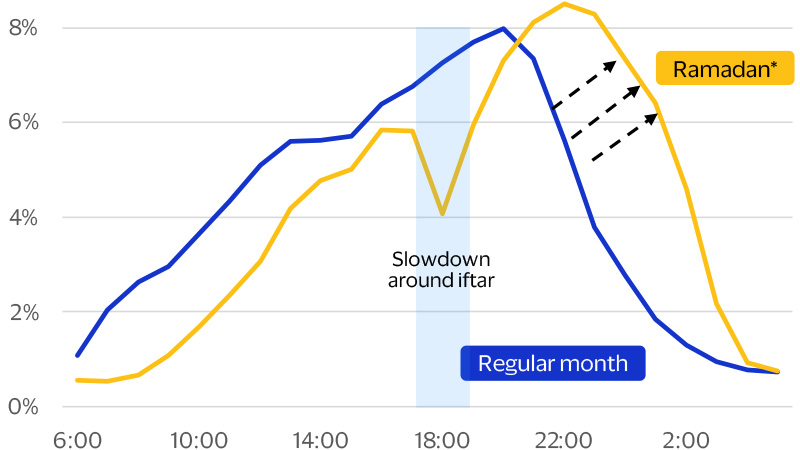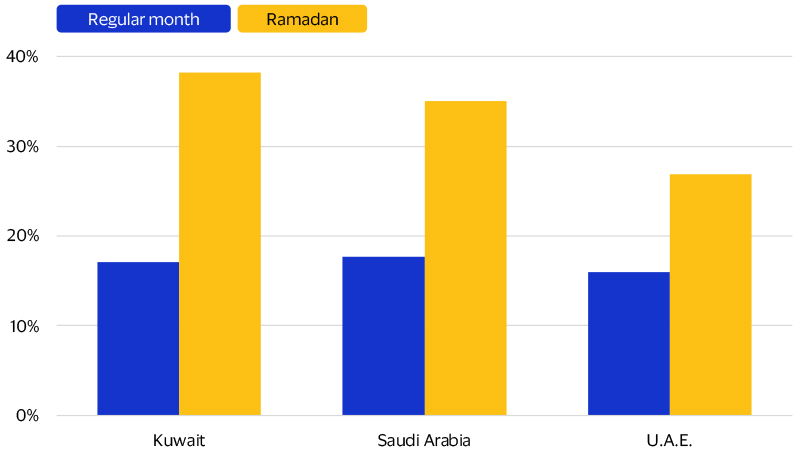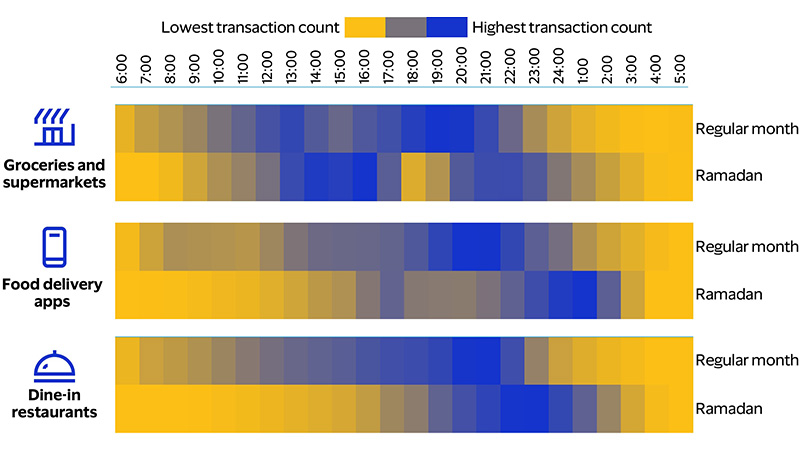The bustling Ramadan night-time economy

March 2025 – During the Muslim holy month of Ramadan, consumer spending in Gulf Cooperation Council countries and other Muslim-majority nations shifts dramatically, with more spending occurring during late-night hours. Anonymized analysis of VisaNet data reveals significant changes across several Muslim countries, where fasting from dawn to sunset alters daily routines and economic behaviors. The timing of spending on some categories also shifts toward the latter part of the month leading up to the Eid al-Fitr holiday. Understanding these shifts allows payment providers to accommodate and anticipate consumers’ needs, such as increasing access to payments during late-night hours or better timing incentives like cashback on food delivery apps. Merchants, particularly those in the food, retail, and hospitality sectors, can also proactively adjust their operating hours and staffing to meet demand during peak times.
On a typical day during Ramadan in Kuwait, for example, consumer spending begins on a quiet note but steadily increases, culminating in a mild surge between 3–5 p.m. as consumers shop for groceries and other essentials to prepare for iftar, the evening meal breaking the fast (see chart below). A notable dip in transaction activity, typically lasting between 5–7 p.m., occurs as families and communities gather to focus on prayers, break their fast and share meals with loved ones. Afterward, transaction activity bounces back as individuals resume their daily routines. This post-iftar surge often extends late into the night, reflecting the unique rhythm of daily life during Ramadan.
Consumer spending shifts to later hours during the holy month of Ramadan*
Transaction distribution by time of day; Kuwait

Source: Visa Business and Economic Insights analysis of VisaNet data
*Data collected from 11 March to 9 April 2024. Kuwait typifies a trend observed in most Muslim countries included in the analysis.
Nocturnal spending: How Ramadan transforms consumer behavior
The ‘night-time economy’ is more prominent during Ramadan*
(Share of total daily transactions from 10 p.m. to 4 a.m.)

Dine-in restaurants and cafes, food delivery apps, groceries and supermarkets, and quick service restaurants experienced the most significant shifts (see heatmap below). A substantial portion of spending occurred between 11 p.m. and 3 a.m.—a marked deviation from normal times. Typically, these categories see peak activity earlier in the evening, but data suggests that this late-night uptick during Ramadan corresponds to the reorganization of daily routines unique to the holy month.
In contrast to iftar, which is usually a home-cooked meal, the pre-dawn meal known as suhoor is often enjoyed at a restaurant or through takeout and food delivery apps. This shift in dining preferences for suhoor drives the late-night demand: Dine-in restaurants and cafes see increased in-person spending well into the night as people enjoy their last meals before fasting begins at sunrise. Convenience becomes a priority for many who prefer to dine at home, increasing demand on food delivery apps during these hours. Similarly, late-night shopping at grocery stores and supermarkets spikes as consumers stock up on essentials.
Ramadan* spending shifts most pronounced in groceries, food delivery apps and dine-in restaurants
(Heatmap of busiest hours by transaction count and merchant categories; Kuwait)

Sources: Visa Business and Economic Insights analysis of VisaNet data
*Data collected from 11 March to 9 April 2024
Countdown to Eid festivities spurs a spending surge
Spending habits during Ramadan are not uniform. They change considerably as the month progresses. Spending on groceries and supermarkets in the days immediately before the start of Ramadan and in the first couple of weeks increases as households stock up on essential items to prepare for fasting. In contrast, the final 10 days see a gradual shift to a higher concentration of spending on clothing and apparel, department store purchases, and luxury items as families and individuals buy new outfits and gifts in preparation for the Eid celebrations.
Both the spending amount and the number of transactions leading up to Eid can reach multiples of what is observed over a normal 10-day period. For example, during the last 10 days of Ramadan in 2024, luxury merchants in Saudi Arabia experienced 2.9 times their average number of transactions. Department stores saw an increase of 1.3 times, and clothing and apparel merchants saw 2.6 times more transactions. Kuwait and the U.A.E. showed similar trends (see figure below). This period reflects heightened economic activity driven by the cultural and religious significance of looking presentable and exchanging gifts during Eid.
Demand surges in the last 10 days of Ramadan* in preparation for Eid celebrations
(Number of transactions by merchant type, benchmarked vs. normal 10-day period)

Sources: Visa Business and Economic Insights analysis of VisaNet data
*Data collected from 11 March to 9 April 2024
Understanding Ramadan trends: strategic insights for banks and merchants
Understanding the distinctive spending patterns during Ramadan can help banks and merchants better cater to their customers' needs. For example, banks can anticipate consumers’ increased spending during late-night hours by ensuring their digital banking services and customer support are robust and responsive during these periods, making it easier for customers to manage their finances when they need it most. Additionally, tailored financial products such as cashback on food delivery apps or discounts at grocery stores can provide value to consumers during this time.
Merchants in the food, retail, and hospitality sectors can consider the consumer implications of extended late-night activity. Customers may appreciate extended operating hours and enhanced staffing to accommodate their needs during peak times. Special promotions and marketing campaigns that align with the last 10 days of Ramadan can help consumers prepare for Eid, offering deals and conveniences that resonate with their heightened activity. By focusing on the unique needs and behaviors of consumers during Ramadan, banks and merchants can naturally enhance customer satisfaction and loyalty, fostering a stronger connection with their customers.
Forward-Looking Statements
This report may contain forward-looking statements within the meaning of the U.S. Private Securities Litigation Reform Act of 1995. These statements are generally identified by words such as “outlook”, “forecast”, “projected”, “could”, “expects”, “will” and other similar expressions. Examples of such forward-looking statements include, but are not limited to, statements we make about Visa’s business, economic outlooks, population expansion and analyses. All statements other than statements of historical fact could be forward-looking statements, which speak only as of the date they are made, are not guarantees of future performance and are subject to certain risks, uncertainties and other factors, many of which are beyond our control and are difficult to predict. We describe risks and uncertainties that could cause actual results to differ materially from those expressed in, or implied by, any of these forward-looking statements in our filings with the SEC. Except as required by law, we do not intend to update or revise any forward-looking statements as a result of new information, future events or otherwise.
Disclaimers
The views, opinions, and/or estimates, as the case may be (“views”), expressed herein are those of the Visa Business and Economic Insights team and do not necessarily reflect those of Visa executive management or other Visa employees and affiliates. This presentation and content, including estimated economic forecasts, statistics, and indexes are intended for informational purposes only and should not be relied upon for operational, marketing, legal, technical, tax, financial or other advice and do not in any way reflect actual or forecasted Visa operational or financial performance. Visa neither makes any warranty or representation as to the completeness or accuracy of the views contained herein, nor assumes any liability or responsibility that may result from reliance on such views. These views are often based on current market conditions and are subject to change without notice.
Visa’s team of economists provide business and economic insights with up-to-date analysis on the latest trends in consumer spending and payments. Sign up today to receive their regular updates automatically via email.